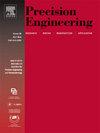Modeling of material removal in pre-structured magnetorheological elastic polishing based on lame differential equation and its experimental validation
IF 3.5
2区 工程技术
Q2 ENGINEERING, MANUFACTURING
Precision Engineering-Journal of the International Societies for Precision Engineering and Nanotechnology
Pub Date : 2025-04-19
DOI:10.1016/j.precisioneng.2025.04.024
引用次数: 0
Abstract
Magnetorheological elastic polishing is a new polishing method for aluminum alloy mirrors due to its high polishing efficiency and low processing damage. However, the traditional polishing pressure model is not applicable to magnetorheological elasticity polishing processing conditions due to the lack of supporting removal theory. As a result, the processing can only rely on experience, often leading to the problem of uneven polishing. In order to achieve the MREP process improvement and enhance the polishing of aluminum alloys, a pre-structured magnetorheological elastic polishing (MREP) removal method is proposed. In this study, the gradient magnetic field excited by permanent magnets was calculated based on the molecular current model. The interaction between magnetized particles in the magnetic chain inside the magnetorheological elastic polishing head was analyzed by using the magnetic dipole model, and the elastic modulus E was constructed as a function of the gradient magnetic field. Using the idea of finite elements, the machining pressure of MREPH was solved according to Hooke's law and lame differential equation. A mathematical model of the material removal function of MREPH was developed by combining Preston's equation. To verify the accuracy of the contact pressure model, the contact pressure was measured by using vision sensors and pressure sensors. The accuracy of the established material removal model was verified by polishing experiments. Fixed-point polishing and single trajectory polishing were experimented. Moreover, the relationships between the polishing effects and the process parameters (Polishing speed, extrusion depth, and polishing magnetic field strength) were investigated. According to the generated material removal map and above impact relationship, process optimization can be carried out. Finally the excellent surface quality was obtained. Sa decreased from 187.368 nm to 20.385 nm (Optimized by 89.1 %). Sz decreased from 1372.539 nm to 164.441 nm (Optimized by 88.0 %). Ra decreased from 245.109 nm to 25.835 nm (Optimized by 89.4 %). PV decreased from 714.921 nm to 85.163 nm (Optimized by 88.1 %).

基于lame微分方程的预结构磁流变弹性抛光材料去除建模及实验验证
磁流变弹性抛光是一种新型的铝合金镜面抛光方法,具有抛光效率高、加工损伤小等优点。然而,由于缺乏支撑去除理论,传统的抛光压力模型并不适用于磁流变弹性抛光加工条件。因此,加工只能依靠经验,往往导致抛光不均匀的问题。为了改进MREP工艺,提高铝合金的抛光性能,提出了一种预结构磁流变弹性抛光去除方法。在本研究中,基于分子电流模型计算了永磁体激发的梯度磁场。利用磁偶极子模型分析了磁流变弹性抛光头内部磁链中磁化颗粒之间的相互作用,并构造了弹性模量E作为梯度磁场的函数。利用有限元的思想,根据胡克定律和lame微分方程求解了MREPH的加工压力。结合Preston方程,建立了MREPH材料去除函数的数学模型。为了验证接触压力模型的准确性,采用视觉传感器和压力传感器对接触压力进行测量。通过抛光实验验证了所建立的材料去除模型的准确性。进行了定点抛光和单轨迹抛光实验。此外,还研究了抛光效果与工艺参数(抛光速度、挤出深度和抛光磁场强度)的关系。根据生成的材料去除图和上述影响关系,可以进行工艺优化。最终获得了优良的表面质量。Sa从187.368 nm减小到20.385 nm(优化89.1%)。Sz从1372.539 nm减小到164.441 nm(优化幅度为88.0%)。Ra从245.109 nm降至25.835 nm(优化89.4%)。PV从714.921 nm减小到85.163 nm(优化幅度为88.1%)。
本文章由计算机程序翻译,如有差异,请以英文原文为准。
求助全文
约1分钟内获得全文
求助全文
来源期刊
CiteScore
7.40
自引率
5.60%
发文量
177
审稿时长
46 days
期刊介绍:
Precision Engineering - Journal of the International Societies for Precision Engineering and Nanotechnology is devoted to the multidisciplinary study and practice of high accuracy engineering, metrology, and manufacturing. The journal takes an integrated approach to all subjects related to research, design, manufacture, performance validation, and application of high precision machines, instruments, and components, including fundamental and applied research and development in manufacturing processes, fabrication technology, and advanced measurement science. The scope includes precision-engineered systems and supporting metrology over the full range of length scales, from atom-based nanotechnology and advanced lithographic technology to large-scale systems, including optical and radio telescopes and macrometrology.

 求助内容:
求助内容: 应助结果提醒方式:
应助结果提醒方式:


